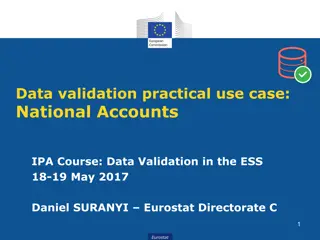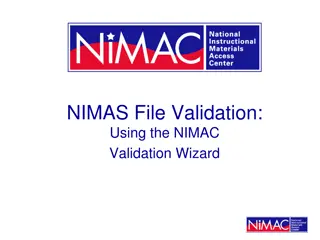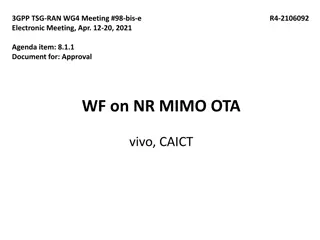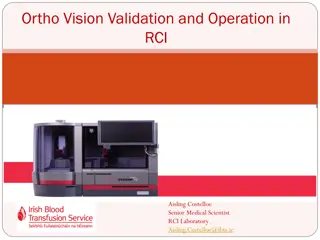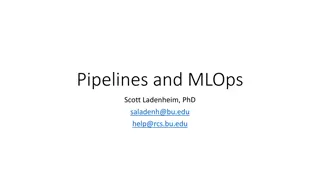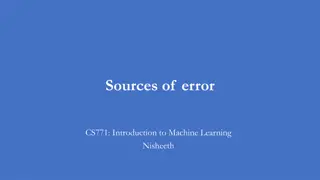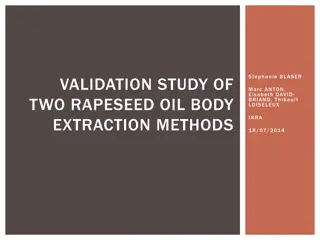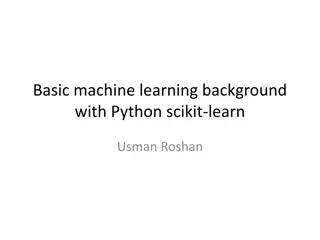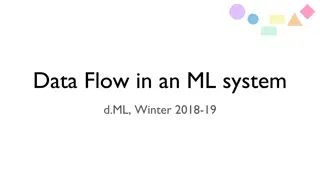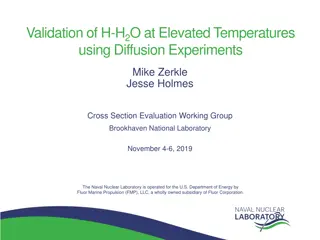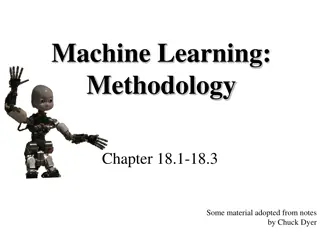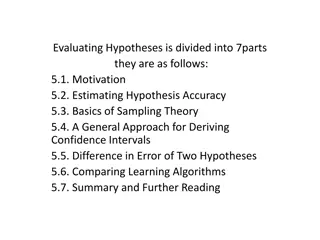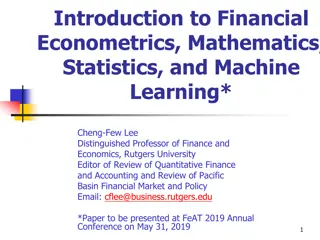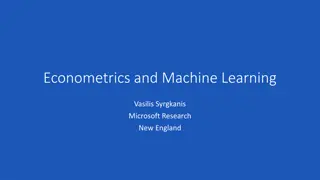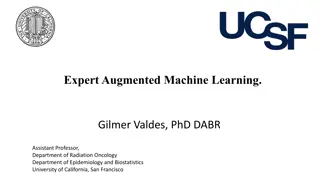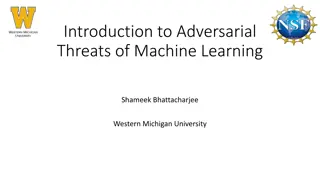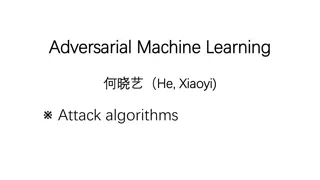Understanding Evaluation and Validation Methods in Machine Learning
Classification algorithms in machine learning require evaluation to assess their performance. Techniques such as cross-validation and re-sampling help measure classifier accuracy. Multiple validation sets are essential for comparing algorithms effectively. Statistical distribution of errors aids in evaluating classifiers based on validation errors.
Download Presentation

Please find below an Image/Link to download the presentation.
The content on the website is provided AS IS for your information and personal use only. It may not be sold, licensed, or shared on other websites without obtaining consent from the author. Download presentation by click this link. If you encounter any issues during the download, it is possible that the publisher has removed the file from their server.
E N D
Presentation Transcript
Module 3 Classification Cross validation and re-sampling methods K-fold cross validation, Boot strapping Measuring classifier performance- Precision, recall, ROC curves. Bayes Theorem, Bayesian classifier, Maximum Likelihood estimation, Density functions, Regression
Evaluation of classifiers In machine learning, there are several classification algorithms and, given a certain problem, more than one may be applicable. There is a need to examine how we can assess how good a selected algorithm is. Also, we need a method to compare the performance of two or more different classification algorithms. These methods help us choose the right algorithm in a practical situation.
Methods of evaluation Need for multiple validation sets Statistical distribution of errors No-free lunch theorem Other factors
Need for multiple validation sets When we apply a classification algorithm in a practical situation, we always do a validation test. We keep a small sample of examples as validation set and the remaining set as the training set. The classifier developed using the training set is applied to the examples in the validation set. Based on the performance on the validation set, the accuracy of the classifier is assessed. But, the performance measure obtained by a single validation set alone does not give a true picture of the performance of a classifier.
Need for multiple validation sets Also these measures alone cannot be meaningfully used to compare two algorithms. This requires us to have different validation sets. Cross-validation in general, and k-fold cross-validation in particular, are two common method for generating multiple training-validation sets from a given dataset Sample data repeatedly from same sample- re-sampling
Statistical distribution of errors We use a classification algorithm on a dataset and generate a classifier. If we do the training once, we have one classifier and one validation error. To average over randomness (in training data, initial weights, etc.), we use the same algorithm and generate multiple classifiers. We test these classifiers on multiple validation sets and record a sample of validation errors.
Statistical distribution of errors We base our evaluation of the classification algorithm on the statistical distribution of these validation errors. We can use this distribution for assessing the expected error rate of the classification algorithm for that problem, or compare it with the error rate distribution of some other classification algorithm.
No-free lunch theorem Whatever conclusion we draw from our analysis is conditioned on the dataset we are given. We are not comparing classification algorithms in a domain-independent way but on some particular application. We are not saying anything about the expected error-rate of a learning algorithm, or comparing one learning algorithm with another algorithm, in general. Any result we have is only true for the particular application.
No-free lunch theorem There is no such thing as the best learning algorithm. For any learning algorithm, there is a dataset where it is very accurate and another dataset where it is very poor. This is called the No Free Lunch Theorem
Other factors Classification algorithms can be compared based not only on error rates but also on several other criteria like the following: training time and space complexity, testing time and space complexity, interpretability, namely, whether the method allows knowledge extraction which can be checked and validated by experts, easy programmability.
Cross-validation To test the performance of a classifier, we need to have a number of training/validation set pairs from a dataset X. To get them, if the sample X is large enough, we can randomly divide it then divide each part randomly into two and use one half for training and the other half for validation. Unfortunately, datasets are never large enough to do this. So, we use the same data split differently; this is called cross-validation.
Cross-validation Cross-validation is a technique to evaluate predictive models by partitioning the original sample into a training set to train the model, and a test set to evaluate it. The holdout method is the simplest kind of cross validation.
Cross-validation The data set is separated into two sets, called the training set and the testing set. The algorithm fits a function using the training set only. Then the function is used to predict the output values for the data in the testing set (it has never seen these output values before). The errors it makes are used to evaluate the model.
K-fold cross-validation In K-fold cross-validation, the dataset X is divided randomly into K equal-sized parts, Xi, i = 1, . . . , K. To generate each pair, we keep one of the K parts out as the validation set Vi, and combine the remaining K 1 parts to form the training set Ti. Doing this K times, each time leaving out another one of the K parts out, we get K pairs (Vi, Ti): V1= X1, T1= X2 X3 . . . XK V2= X2, T2 = X1 X3 . . . XK VK= XK, TK = X1 X2 . . . XK-1
K-fold cross-validation There are two problems with this: To keep the training set large, we allow validation sets that are small. The training sets overlap considerably, namely, any two training sets share K 2 parts. K is typically 10 or 30. As K increases, the percentage of training instances increases and we get more robust estimators, but the validation set becomes smaller. Furthermore, there is the cost of training the classifier K times, which increases as K is increased.
Leave-one-out cross-validation An extreme case of K-fold cross-validation is leave- one-out where given a dataset of N instances, only one instance is left out as the validation set and training uses the remaining N 1 instances. We then get N separate pairs by leaving out a different instance at each iteration. This is typically used in applications such as medical diagnosis, where labeled data is hard to find.
5 2 cross-validation In this method, the dataset X is divided into two equal parts X1(1)and X1(2). We take as the training set X1(1and X1(2) as the validation set. We then swap the two sets and take X1(2) as the training set and X1(1) as the validation set. This is the first fold. The process id repeated four more times to get ten pairs of training sets and validation sets.
5 2 cross-validation T1 = X1(1) , T2 = X1(2) , T3 = X2(1) , T4 = X2(2) , T9 = X5(1) , T10 = X5(2) , V1 = X1(2) V2 = X1(1) V3 = X2(2) V4 = X2(1) V3 = X5(2) V10 = X5(1)
5 2 cross-validation After five folds, the validation error rates become too dependent and do not add new information. If there are fewer than five folds, we get fewer data (fewer than ten) and will not have a large enough sample to fit a distribution and test our hypothesis. Final accuracy = Average(Round1 accuracy + --- +Round n accuracy)
Bootstrapping In statistics, the term bootstrap sampling , the bootstrap or bootstrapping for short, refers to process of random sampling with replacement . repeated sampling from data with replacement and repeated estimation Subsample will have same number of observations Same observation can be selected many times Probability of selecting each observation is same
Example For example, let there be five balls labeled A, B, C, D, E in an urn. We wish to select different samples of balls from the urn each sample containing two balls. The following procedure may be used to select the samples. This is an example for bootstrap sampling. We select two balls from the basket. Let them be A and E. Record the labels. Put the two balls back in the basket. We select two balls from the basket. Let them be C and E. Record the labels. Put the two balls back into the basket. This is repeated as often as required. So we get different samples of size 2, say, A, E; B, E; etc. These samples are obtained by sampling with replacement, that is, by bootstrapping.
Bootstrapping in machine learning In machine learning, bootstrapping is the process of computing performance measures using several randomly selected training and test datasets which are selected through a process of sampling with replacement, that is, through bootstrapping. Sample datasets are selected multiple times. The bootstrap procedure will create one or more new training datasets some of which are repeated. The corresponding test datasets are then constructed from the set of examples that were not selected for the respective training datasets.
Measuring error Consider a binary classification model derived from a two-class dataset. Let the class labels be c and c. Let x be a test instance.
Measuring error True positive Let the true class label of x be c. If the model predicts the class label of x as c, then we say that the classification of x is true positive. False negative Let the true class label of x be c. If the model predicts the class label of x as c, then we say that the classification of x is false negative. True negative Let the true class label of x be c. If the model predicts the class label of x as c, then we say that the classification of x is true negative. False positive Let the true class label of x be c. If the model predicts the class label of x as c, then we say that the classification of x is false positive.
Confusion matrix A confusion matrix is used to describe the performance of a classification model (or classifier ) on a set of test data for which the true values are known. A confusion matrix is a table that categorizes predictions according to whether they match the actual value
Confusion matrix Actual label of x is c Actual Label of x is c Predicted value of x in c True Positive False Positive Predicted value of x in c False Negative True Negative
Two-class datasets For a two-class dataset, a confusion matrix is a table with two rows and two columns that reports the number of false positives, false negatives, true positives, and true negatives. Assume that a classifier is applied to a two-class test dataset for which the true values are known. Let TP denote the number of true positives in the predicted values, TN the number of true negatives, etc.
Two-class datasets Actual Condition is true Actual Condition is false Predicted condition is true True Positive False Positive Predicted condition is false False Negative True Negative
Multiclass datasets - Example Confusion matrices can be constructed for multiclass datasets also. If a classification system has been trained to distinguish between cats, dogs and rabbits, a confusion matrix will summarize the results of testing the algorithm for further inspection. Assuming a sample of 27 animals - 8 cats, 6 dogs, and 13 rabbits, the resulting confusion matrix could look like the table below:
Multiclass datasets Actual cat Actual dog Actual rabbit Predicted cat Predicted dog Predicted rabbit 5 2 0 3 3 2 0 1 11 This confusion matrix shows that, for example, of the 8 actual cats, the system predicted that three were dogs, and of the six dogs, it predicted that one was a rabbit and two were cats.
Precision and recall In machine learning, precision and recall are two measures used to assess the quality of results produced by a binary classifier. They are formally defined as follows. Let a binary classifier classify a collection of test data. Let TP = Number of true positives TN = Number of true negatives FP = Number of false positives FN = Number of false negatives The precision P is defined as P = TP/( TP + FP) The recall R is defined as R = TP/( TP + FN)
Problem 1 Suppose a computer program for recognizing dogs in photographs identifies eight dogs in a picture containing 12 dogs and some cats. Of the eight dogs identified, five actually are dogs while the rest are cats. Compute the precision and recall of the computer program.
Problem 1 TP = 5 FP = 3 FN = 7 The precision P is P = TP/( TP + FP) = 5/( 5 + 3) = 5/ 8 The recall R is R = TP/( TP + FN) = 5/( 5 + 7) = 5/ 12
Problem 2 Let there be 10 balls (6 white and 4 red balls) in a box and let it be required to pick up the red balls from them. Suppose we pick up 7 balls as the red balls of which only 2 are actually red balls. What are the values of precision and recall in picking red ball?
Problem 2 TP = 2 FP = 7 2 = 5 FN = 4 2 = 2 The precision P is P = TP/( TP + FP) = 2/( 2 + 5) = 2/ 7 The recall R is R = TP/( TP + FN ) = 2/(2 + 2) = 1/2
Problem 3 A database contains 80 records on a particular topic of which 55 are relevant to a certain investigation. A search was conducted on that topic and 50 records were retrieved. Of the 50 records retrieved, 40 were relevant. Construct the confusion matrix for the search and calculate the precision and recall scores for the search. Each record may be assigned a class label relevant" or not relevant . All the 80 records were tested for relevance. The test classified 50 records as relevant . But only 40 of them were actually relevant.
Problem 3 Actual Relevant Actual Not Relevant Predicted Relevant 40 10 Predicted Not Relevant 15 25
Problem 3 TP = 40 FP = 10 FN = 15 The precision P is P = TP/( TP + FP) = 40/( 40 + 10) = 4/ 5 The recall R is R = TP/( TP + FN) = 40/( 40 + 15) = 40/ 55
Other measures of performance Using the data in the confusion matrix of a classifier of two- class dataset, several measures of performance have been defined. Accuracy = (TP + TN)/( TP + TN + FP + FN ) Error rate = 1 Accuracy Sensitivity = TP/( TP + FN) Specificity = TN /(TN + FP) F-measure = (2 TP)/( 2 TP + FP + FN)
Receiver Operating Characteristic (ROC) The acronym ROC stands for Receiver Operating Characteristic, a terminology coming from signal detection theory. The ROC curve was first developed by electrical engineers and radar engineers during World War II for detecting enemy objects in battlefields. They are now increasingly used in machine learning and data mining research.
TPR and FPR Let a binary classifier classify a collection of test data. TP = Number of true positives TN = Number of true negatives FP = Number of false positives FN = Number of false negatives TPR = True Positive Rate = TP/( TP + FN )= Fraction of positive examples correctly classified = Sensitivity FPR = False Positive Rate = FP /(FP + TN) = Fraction of negative examples incorrectly classified = 1 Specificity
ROC space We plot the values of FPR along the horizontal axis (that is , x-axis) and the values of TPR along the vertical axis (that is, y-axis) in a plane. For each classifier, there is a unique point in this plane with coordinates (FPR,TPR). The ROC space is the part of the plane whose points correspond to (FPR,TPR). Each prediction result or instance of a confusion matrix represents one point in the ROC space.
ROC space The position of the point (FPR,TPR) in the ROC space gives an indication of the performance of the classifier. For example, let us consider some special points in the space One step higher for positive examples and one step right for negative examples
Special points in ROC space The left bottom corner point (0, 0): Always negative prediction A classifier which produces this point in the ROC space never classifies an example as positive, neither rightly nor wrongly, because for this point TP = 0 and FP = 0. It always makes negative predictions. All positive instances are wrongly predicted and all negative instances are correctly predicted. It commits no false positive errors.
Special points in ROC space The right top corner point (1, 1): Always positive prediction A classifier which produces this point in the ROC space always classifies an example as positive because for this point FN = 0 and TN = 0. All positive instances are correctly predicted and all negative instances are wrongly predicted. It commits no false negative errors.
Special points in ROC space The left top corner point (0, 1): Perfect prediction A classifier which produces this point in the ROC space may be thought as a perfect classifier. It produces no false positives and no false negatives
Special points in ROC space Points along the diagonal: Random performance Consider a classifier where the class labels are randomly guessed, say by flipping a coin. Then, the corresponding points in the ROC space will be lying very near the diagonal line joining the points (0, 0) and (1, 1).
ROC curve In the case of certain classification algorithms, the classifier may depend on a parameter. Different values of the parameter will give different classifiers and these in turn give different values to TPR and FPR. The ROC curve is the curve obtained by plotting in the ROC space the points (TPR , FPR) obtained by assigning all possible values to the parameter in the classifier



